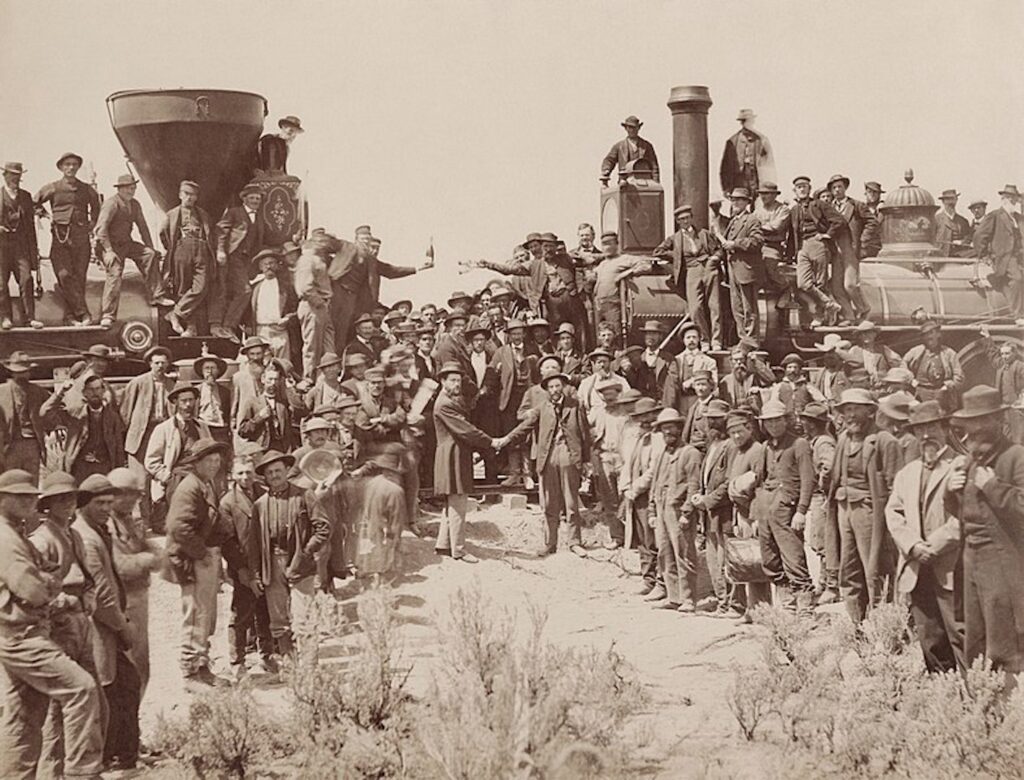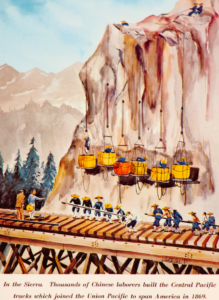Name a Chinese American historical hero. No dice? How about one of Asian American descent? Still struggling? You should be, said Museum of Chinese in America (MOCA) President Nancy Yao Maasbach in her introduction to her museum’s current exhibition.
She was speaking in the museum’s peaceful glass atrium just a block or two away from the bustle of Canal Street in New York City’s Chinatown. Since relocating a decade ago, MOCA has unrelentingly shone a spotlight on the untold stories of Chinese communities within the US. It’s a bold attempt to compensate where history books fail — and one that has come into sharp focus this year during the 150th anniversary of the Transcontinental Railway.

East and West Shaking hands at the laying of last rail Union Pacific Railroad. Image: Golden Spike Ceremony, Promontory, Utah, May 10, 1869. Wikipedia/Yale Collection of Western Americana.
The exhibition on this topic, The Chinese Helped Build the Railroad — The Railroad Helped Build America, is a photographic study of an overlooked milestone in American history and the laborers that made it possible. The 2,000-mile railroad tracks became a key economic mechanism for a resource-rich nation by reducing the cost of crossing America by over 80 percent. Yet, sadly, the 12,000-plus Chinese laborers who were instrumental in accomplishing this feat (many of whom were recruited through field offices in what is today Guangzhou province) have never been properly acknowledged, hence this extraordinary exhibition. The staged celebratory photograph from 1869 of the meeting of the two railroad labor teams makes this point poignantly clear; there isn’t a single Chinese face recorded for posterity.
Alongside this exhibition, the museum has also undertaken a unique project that honors these rail workers. Swapping out shovels and stakes for sneakers, MOCA reimagined the Herculean task of building the Transcontinental Railway by enlisting 1,500 runners to dash nationwide over a 150 day period. Since April, participants have run over 190,000 miles in a coordinated effort that will culminate on November 3 at the New York City Marathon.
A big part of MOCA’s effort to mark the anniversary through this exhibition and its related events was to bring together the different waves of Chinese immigrants within the US. “We wanted to connect recent immigrants who have better means and better education with earlier immigrants to say thank you,” says Yao Maasbach. In this fraught moment in US-China relations, this historic reflection seems not only past due but also pertinent.

Postcard of Jake Lee’s painting Laborers Working on the Pacific Railroad created by Kan’s Restaurant in San Francisco, 1963. Courtesy of Chinese Historical Society of America Museum. Image: MOCA
The desire to generate conversation is further evinced in MOCA’s most recent initiatives to deepen the connection between the city’s Chinatown, the Two Bridges neighborhoods, and the museum. It has launched a “Pay What You Wish” admission policy for area residents as well as a grant program that offers free space for up to 20 hours to local non-profit organizations for meetings. “MOCA is a vital backbone to this community,” says Eric Y. Ng, President of the Chinese Consolidated Benevolent Association of New York (CCBA-NY), “It is a place where our stories and history can be shared within Chinatown and with the world.” Based on their recent programs, “community” is certainly a concept MOCA cares deeply about.



